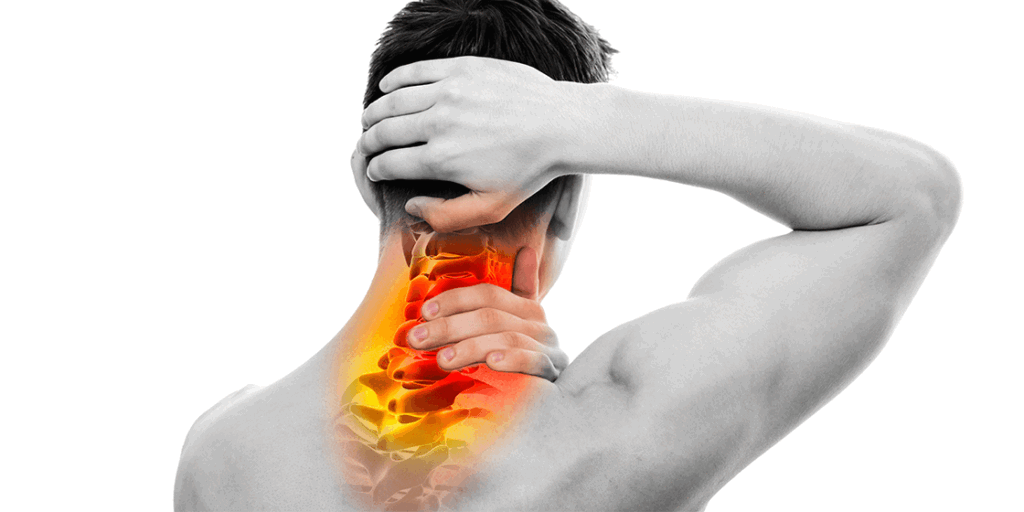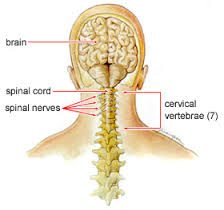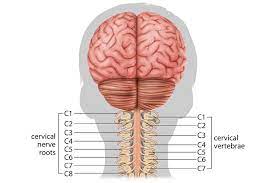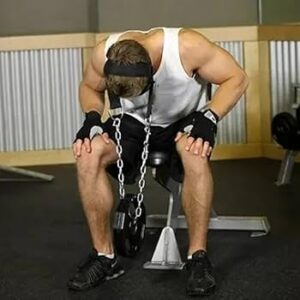

I am over-eager to answer the query, “how forward head posture affected my C4 vertebrae?”
Do you know the reason why???
Well, the answer is simple enough, “My C4 vertebrae bore the brunt of the impact delivered by my bad neck posture.”
The pain, stiffness of the neck muscle, nagging stretch of the upper back muscle and a constant pressure onto my throat, was a part and parcel of what my traumatized C4 cervical vertebrae unleashed.
While all this was owing to my forward neck, I largely ignored it until the discomfort became almost unbearable.
This is when I researched, paid a visit to a certified medical representative and realized the extent of damage a seemingly normal “text neck” does to the cervical vertebrae.
Allow me to share my experience:
Article Index:
1) What is the C4 Cervical Vertebrae?
2) A Quick Look at the Structure of My C4 Vertebrae
3) What is the Primary Role of My C4 Cervical Vertebrae?
4) How did I Get a Nerd Neck without Trying Too Hard?
5) How did My Forward Head Posture Impact My C4 Vertebrae?
6) Top 5 Ways I Used to Correct My Damaged C4 Cervical Vertebrae
7) FAQs on C4 Vertebrae & Forward Head Posture
8) Takeaway
What is the C4 Cervical Vertebrae?
Nestled in the neck, the C4 vertebra is the fourth of the seven cervical vertebrae that make up my spinal column.
Think of it as the dependable fourth player in an all-star team, holding the fort and ensuring that your neck stays nimble and strong.
The C4 Squad: Similarities with Its Neighbors
After the unique designs of C1 and C2 cervical vertebrae, the C3 to C6 vertebrae form a harmonious group with similar shapes and functions.
The C4 vertebra, just like its close buddies, is relatively small compared to the other vertebrae but plays a big role in keeping things running smoothly.
The Spacious Foramen: Nerve Superhighway
Despite its modest size, C4 boasts a large vertebral foramen, a spacious passageway for the spinal cord nerves.
This feature is like having a grand freeway in a small town, ensuring all the neural traffic flows without a hitch.
Transverse Foramina: The VIP Passages
C4 is equipped with not just one but two transverse foramina in its vertebral arch.
These exclusive passageways allow the sympathetic nerves, vertebral vein, and vertebral artery to travel from the spinal column to the rest of the body.
Imagine them as secret tunnels for VIP guests, providing a smooth and protected journey.
Articulation and Cushioning: The Smooth Operators
The vertebral body, or centrum, along with the superior and inferior articular facets, work seamlessly with the C3 vertebra above and the C5 below.
As per bestforwardheadposturefix.com research, “This collaboration allows for smooth articulation of the spine, cushioned by intervertebral discs”. It is like a well-choreographed dance, with each vertebra playing its part to perfection.
The Bifid Spinous Process: Muscle and Ligament Connection
Behind the vertebral arch, you’ll find the notched (bifid) spinous process of C4.
This distinctive feature extends outward, providing crucial attachment points for muscles and ligaments.
Think of it as the sturdy hook that keeps everything in place, ensuring your neck muscles and ligaments can perform their duties effectively.
Free Tip of the Day:
With its unique structure and vital functions, the C4 vertebra is an essential player in the cervical spine team.
It ensures your neck remains flexible, stable, and ready for action, whether you’re nodding in agreement or turning to catch a glimpse of something intriguing.
Time to say hello to C4, the unsung hero keeping your head in the game!
A Quick Look at the Structure of My C4 Vertebrae
Welcome to the exciting world of the C4 cervical vertebra!
Positioned in the middle of the cervical spine, C4 is like the efficient middle manager, ensuring everything runs smoothly between the upper and lower regions of your neck.
It is the fourth vertebra in the spinal column, nestled comfortably below C3 and above C5, playing a crucial role in neck stability and movement.
The Classic Vertebra Shape
C4, like its neighbor C3, sports the classic vertebral shape. At the front, it features a sturdy vertebral body that forms the core of its structure.
This vertebral body is wider than it is deep, providing a solid foundation for the vertebra.
The top and bottom surfaces are slightly concave with a gentle lip around the edges, giving it a sleek, aerodynamic look.
Scientific Evidence:
- Study: A study in Spine (2015) explores the structural uniformity of cervical vertebrae from C3 to C7, highlighting their common features and functional significance.
The Intervertebral Discs: Cushions of Comfort
Above and below C4, you’ll find the intervertebral discs—your spine’s very own shock absorbers.
These soft, cartilaginous discs provide the flexibility and cushioning needed for a wide range of neck movements, from nodding in agreement to tilting your head in curiosity.
Scientific Evidence:
- Study: Research in the Journal of Orthopaedic Research (2018) details the biomechanical properties of intervertebral discs and their crucial role in spinal flexibility and cushioning.
The Vertebral Arch: A Protective Passage
Extending from the sides of the vertebral body, the vertebral arch forms a protective passageway for the spinal cord.
The arch is made up of several components, including the pedicles, laminae, and transverse processes. These elements work together like a well-oiled machine, ensuring the spinal cord is safe and sound.
Scientific Evidence:
- Study: An article in Clinical Anatomy (2020) describes the structure and function of the vertebral arch, emphasizing its role in spinal cord protection and stability.
The Transverse Processes: Functional Extensions
The transverse processes of C4 extend laterally from the vertebral body, featuring anterior and posterior tubercles.
These processes serve as attachment points for muscles and ligaments, playing a key role in neck movement and stability.
Picture them as the versatile arms of the vertebra, reaching out to support various functions.
Scientific Evidence:
- Study: The Journal of Anatomy (2017) investigates the anatomy and biomechanics of transverse processes, highlighting their importance in muscle attachment and movement.
The Articular Processes: Joint Connections
C4’s superior and inferior articular processes form joints with the neighboring vertebrae (C3 above and C5 below).
These planar synovial joints allow for smooth, gliding movements, making it possible for your neck to flex, extend, and rotate with ease. It is like having a finely-tuned pivot system in your spine.
Scientific Evidence:
- Study: The Spine Journal (2019) reviews the anatomy and function of cervical facet joints, underscoring their role in neck mobility and stability.
The Spinous Process: The Vertebral Flagpole
Finally, we have the spinous process—a single, prominent projection extending from the back of the vertebral arch.
This process serves as a key attachment point for muscles and ligaments, helping to keep your neck aligned and stable.
Think of it as the flagpole proudly flying the banner of spinal health.
Scientific Evidence:
- Study: An investigation in Spine (2021) explores the structural and functional aspects of spinous processes, noting their significance in muscle attachment and spinal stability.
Free Tip of the Day:
With its intricate design and vital roles, the C4 vertebra is a masterful blend of form and function, ensuring your neck remains flexible, stable, and strong.
A big round of applause for C4, the middle manager of my cervical spine, keeping everything in check and running smoothly!
What is the Primary Role of My C4 Cervical Vertebrae?
My C4 cervical vertebra is a crucial player in my neck’s anatomy, acting as the reliable middle manager among my seven cervical vertebrae.
It is the fourth vertebra in line, nestled snugly between C3 and C5, ensuring everything runs smoothly.
Here is what all it does for me:
Support and Stability: Holding Up My Head
My C4 is key to maintaining neck stability and supporting the weight of my head. I think of it as the sturdy pillar holding up a precious crown, allowing for balanced and steady movement.
Nerve Superhighway: Protecting My Spinal Cord
One of C4’s primary roles is safeguarding my spinal cord. With its large vertebral foramen, it provides a safe passageway for my nerves, ensuring smooth communication between my brain and the rest of my body.
It’s like a VIP tunnel for my nervous system!
Flexibility and Motion: Smooth Operator
My C4, along with its neighboring vertebrae, facilitates a range of neck movements. Its superior and inferior articular facets, cushioned by intervertebral discs, allow for smooth articulation, making it easy for me to nod, tilt, and rotate my head with ease.
Muscle and Ligament Anchor: The Connection Point
The bifid spinous process of my C4 provides essential attachment points for my muscles and ligaments, keeping my neck flexible and stable.
It is the anchor that ensures my neck muscles and ligaments work together harmoniously.
Free Tip of the Day:
With its vital roles, my C4 is the unsung hero of my neck, ensuring support, protection, and smooth movement. Kudus to my C4, the backbone of my neck’s functionality!
How did I Get a Nerd Neck without Trying Too Hard?
I really do not have to explain how a fit and healthy young man gets a text neck these days. It is just way too obvious. The moment he starts to work at an office and the office gives him a laptop, a nerd neck appears on its own.
I too was a victim of the tech revolution.
It was not just my laptop on which I was hooked for hours at length, even my cellphone was to blame.
Basically, after spending a good 8 hours every day in front of my laptop screen, I spent a remaining 4 hours of my free time scrolling through my cellphone.
Incorrect cellphone screen position caused text neck and my laptop addiction simply made it worse.
These actions (laptop and cellphone) required me to literally crane my neck forward. This forced my head to slide almost 3 inches ahead of its original position.
So, if I took a closer look at my profile picture, I could see my head sitting 3 inches ahead of my shoulders or ear lobes. If some clicked my profile image, it appeared as though I was craning my neck forward.
Ouch! That seemed painful and yes, it did pain as well.
The muscles on my neck, upper back and throat felt stiff and stretched. They did ache as well. With time, the discomfort only worsened.
How did My Forward Head Posture Impact My C4 Vertebrae?
I had always thought my occasional neck pain was just a part of life, something to be ignored and pushed through.
But as time went on, the discomfort became more pronounced, turning into a persistent ache that seemed to originate deep within my neck.
One day, I decided to visit a chiropractor, hoping for a quick fix. Little did I know, I was about to learn a lot about my posture and its effects on my C4 vertebra.
Understanding Forward Head Posture
During my consultation, the chiropractor asked me about my daily habits, particularly my posture while using my computer and phone.
He explained that I exhibited a classic case of Forward Head Posture (FHP). This condition occurs when the head extends forward in relation to the spine, causing a significant strain on the neck muscles and cervical spine.
Research indicates that for every inch the head moves forward, an additional 10 pounds of weight is placed on the cervical spine, leading to various musculoskeletal issues.
Impact on the C4 Vertebra
My chiropractor pointed out that my C4 vertebra, situated in the middle of my neck, was bearing the brunt of my poor posture.
The C4 vertebra plays a critical role in supporting the neck and facilitating movement.
Forward Head Posture was causing my C4 to misalign, resulting in a domino effect on the surrounding vertebrae and muscles.
Studies have shown that neck misalignment can lead to chronic neck pain, headaches, and even nerve compression.
So, all this discomfort was owing to a very simple reason – my inability to maintain a proper neck posture.
The Pain and Its Consequences
As my condition worsened, I began experiencing frequent headaches and a dull, throbbing pain in my neck and shoulders.
At night, the discomfort often made it difficult to find a comfortable sleeping position, affecting my overall sleep quality.
The chiropractor explained that this was due to the continuous stress placed on my C4 vertebra and the surrounding structures, which were now struggling to maintain proper alignment and function.
Top 5 Ways I Used to Correct My Damaged C4 Cervical Vertebrae
After experiencing persistent neck pain and frequent headaches, I decided it was time to take action.
My chiropractor had identified that my C4 vertebra was misaligned due to my poor posture, especially Forward Head Posture.
Determined to alleviate my discomfort, I implemented several strategies to correct this issue.
Here are the top five ways that made a significant difference in my recovery.
- Chiropractic Adjustments
The first step in my journey was regular visits to my chiropractor. Chiropractic adjustments were crucial in realigning my C4 vertebra.
Research supports the effectiveness of chiropractic care in managing cervical spine issues.
Each adjustment session involved gentle manipulations that helped restore the natural curvature of my neck and reduce the strain on my C4 vertebra.
Over time, these adjustments significantly alleviated my pain and improved my range of motion.
- Ergonomic Workstation Setup
Understanding the importance of ergonomics, I made several changes to my workstation. I adjusted my computer screen to eye level to prevent the forward tilt of my head.
I also invested in an ergonomic chair that provided proper support to my lower back and neck. Studies have shown that ergonomic interventions can reduce musculoskeletal strain and improve posture.
These changes helped me maintain a neutral head position, reducing the pressure on my C4 vertebra.
- Neck Strengthening Exercises
My chiropractor recommended specific exercises to strengthen my neck muscles. I incorporated exercises like chin tucks, neck stretches, and shoulder blade squeezes into my daily routine.
Strengthening these muscles helped support my cervical spine, including the C4 vertebra. According to research, targeted exercises can improve neck function and reduce pain.
Consistency with these exercises made a noticeable difference in my neck stability and pain levels.
- Posture Awareness and Correction
Becoming aware of my posture was a game-changer. I started paying attention to how I held my head and neck throughout the day.
Whenever I noticed my head drifting forward, I consciously corrected it by aligning my ears with my shoulders.
This simple habit, supported by scientific evidence, helped reduce the chronic strain on my C4 vertebra.
Over time, maintaining proper posture became second nature.
- Mindful Breaks and Movement
To counteract the effects of prolonged sitting, I incorporated mindful breaks into my daily routine.
Every hour, I would stand up, stretch, and walk around for a few minutes.
Research indicates that frequent breaks and movement can prevent the stiffness and strain associated with extended periods of sitting.
These breaks not only helped my neck but also improved my overall well-being.
Free Tip of the Day:
Through chiropractic care, ergonomic adjustments, targeted exercises, posture correction, and mindful breaks, I managed to alleviate the pain associated with my damaged C4 vertebra.
This journey taught me the importance of proactive measures and the profound impact they can have on spinal health.
By integrating these strategies into my daily life, I was able to restore comfort and functionality to my neck, allowing me to live pain-free.
FAQs on C4 Vertebrae & Forward Head Posture
Q1: How does forward head posture affect the alignment of the C4 vertebra?
Forward head posture causes the upper cervical vertebrae to extend backward while the lower cervical vertebrae, including C4, flex forward. This disrupts the natural curve of the neck, placing extra strain on the C4 vertebra and its surrounding tissues, which can lead to discomfort and misalignment.
Q2: What happens to the intervertebral disc near the C4 vertebra due to forward head posture?
The shifted posture increases pressure on the discs between the vertebrae, particularly the one between C4 and C5. This added stress can accelerate wear and tear, potentially causing disc degeneration or herniation, which may irritate nearby nerves.
Q3: Does forward head posture cause muscle imbalances that impact the C4 vertebra?
Yes, forward head posture typically weakens the deep neck flexor muscles while tightening the muscles at the back of the neck. These imbalances affect the stability and function of the cervical spine, including the C4 vertebra, often leading to pain and reduced mobility.
Q4: How is the stability of the C4 vertebra compromised by forward head posture?
The altered positioning and muscle imbalances from forward head posture can reduce the overall stability of the cervical spine. This instability increases the vulnerability of the C4 vertebra to degeneration and may contribute to chronic neck discomfort.
Q5: What symptoms might indicate that forward head posture is affecting the C4 vertebra?
Common symptoms include neck pain, stiffness, and localized tenderness around the mid-cervical region where C4 sits. These arise from abnormal loading and strain on the vertebra and surrounding structures caused by the poor posture.
Q6: What treatments can help reverse the effects of forward head posture on the C4 vertebra?
Effective approaches include posture-corrective exercises that strengthen weak muscles and stretch tight ones, manual therapy to realign the cervical spine, and ergonomic modifications to reduce strain. These interventions help restore proper alignment and reduce pain associated with C4 vertebra stress.
Takeaway:
It is a well-known fact that most people, across the globe are suffering from bad neck posture.
Also known as vulture neck posture (owing to the forward slide of the head), this unnatural posture has an adverse side effect onto your cervical spine.
I learn the lesson the hard way. Nonetheless, after realizing that I was indeed complicating my cervical spine, I made all the necessary changes to my existing lifestyle to fix my forward head posture fast.
At the end of it all, I was pleasantly surprised that getting my normal neck and head posture back took months.
My suggestion to everyone out there who use cellphones and laptops is to pay particular attention towards their head and neck position while using media devises.
References:


